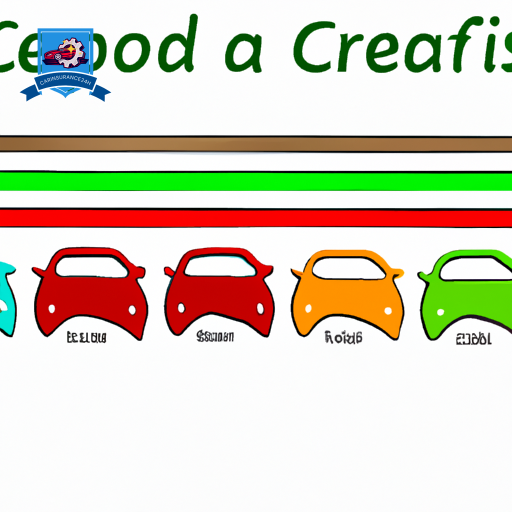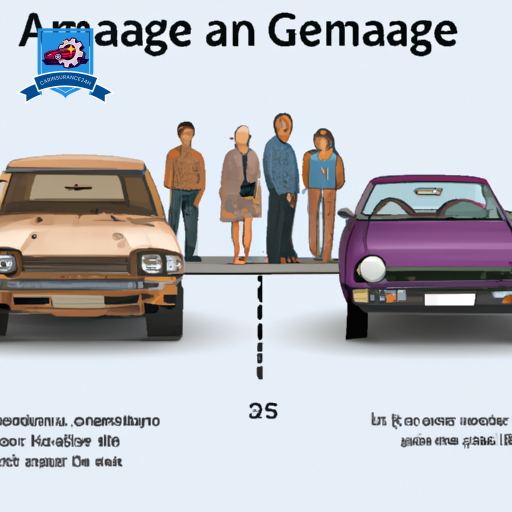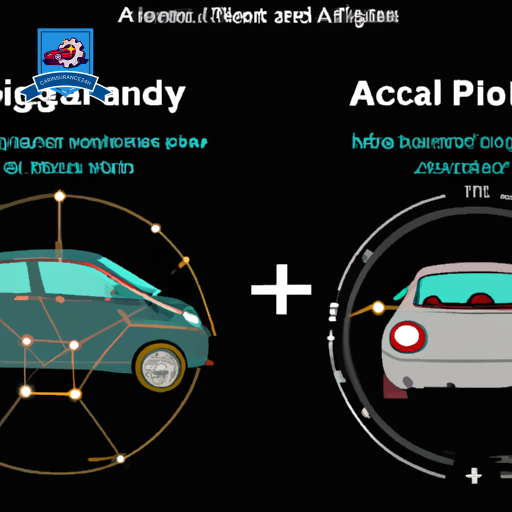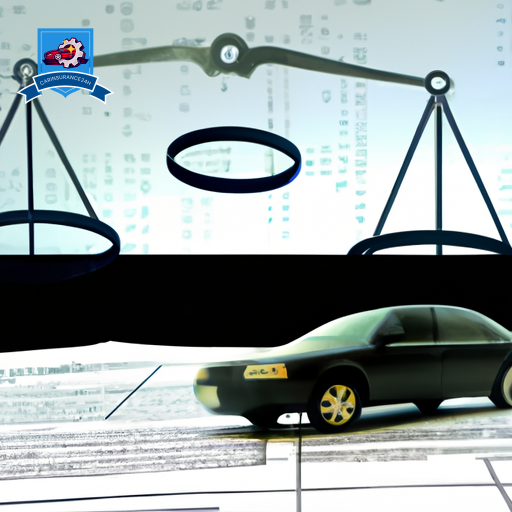In the complex landscape of car insurance, a multitude of factors plays a pivotal role in determining the premiums that policyholders must pay. Key elements such as the type of vehicle, an individual’s driving history, and their credit score are just the tip of the iceberg.
Additionally, age, gender, location, and even marital status can greatly sway the cost of insurance. This intricate interplay of variables not only affects affordability but also the extent of coverage one can secure.
As we explore these factors in further detail, it becomes clear that understanding their influence is essential for anyone looking to optimize their car insurance policy.
Type of Vehicle

The type of vehicle you drive greatly influences your car insurance premiums, with factors such as make, model, and year playing pivotal roles in determining the cost. It’s essential to understand that not all vehicles are created equal in the eyes of insurance companies, with certain attributes such as vehicle color and manufacturer reputation playing a crucial role in determining rates.
Regarding vehicle color, a common misconception persists that brighter cars, like red or yellow, cost more to insure. However, insurance premiums are not directly influenced by color but rather by the make and model associated with certain colors. For example, sports cars, which are more frequently produced in brighter colors, often have higher insurance costs due to their higher performance capabilities and associated risk, not the color itself.
Manufacturer reputation also plays a critical role in insurance premium calculations. Vehicles produced by manufacturers known for safety and reliability often receive more favorable insurance rates. This is because historical data supports that these vehicles are less likely to be involved in accidents or require costly repairs. Conversely, brands with a reputation for mechanical issues or poor safety ratings may see higher insurance premiums due to the increased risk they represent.
Driving History

Your driving history is a critical factor that insurance companies consider when determining your car insurance premiums. This history provides insurers with a snapshot of your driving behavior, allowing them to assess the level of risk you pose on the road. The more incidents you have on your record, such as traffic tickets or accidents, the higher your perceived risk, and consequently, the higher your insurance rates may be.
Traffic tickets are significant indicators of driving behavior for insurance providers. Violations such as speeding, running red lights, or failing to yield can hike up your premiums substantially. These infractions suggest a disregard for traffic laws and an increased likelihood of being involved in an accident. Insurance companies meticulously analyze your driving record for such violations to adjust your premium rates accordingly.
Weather conditions also play an indirect role in your driving history. Poor weather conditions, like heavy rain, snow, or fog, can lead to more accidents. If you live in an area prone to extreme weather, or your driving history reflects accidents that occurred during poor weather conditions, insurers may view this as a heightened risk. While you cannot control the weather, demonstrating safe driving habits regardless of conditions can mitigate this risk factor.
Credit Score

Moving from driving history, we now turn our attention to the critical role of credit score in car insurance processes.
A credit score not only influences premium rates to a large extent but also opens avenues for consumers to secure more favorable insurance quotes through strategic improvements.
Understanding the nuances of how credit scores impact insurance premiums and the variability in quotes will equip policyholders with essential knowledge for making informed decisions.
Impact on Premium Rates
Understanding the impact of credit scores on car insurance premium rates is essential for policyholders. A credit score reflects one’s financial reliability, which insurers interpret as a measure of risk. This metric greatly influences the cost of premiums, often independent of factors such as policy duration and weather conditions. Here’s how:
- Higher Credit Score: Generally leads to lower premiums, as insurers view the policyholder as low-risk.
- Lower Credit Score: Can result in higher premiums due to perceived increased risk of claims.
- Credit Score Fluctuations: Regular updates to credit scores mean that premium rates may adjust over time.
- Comparison Shopping: Insurers weigh credit scores differently, so premiums can vary across companies for the same coverage level.
Understanding this relationship enables policyholders to navigate their insurance options more effectively.
Score Improvement Tips
Improving one’s credit score is a strategic approach to potentially lowering car insurance premium rates. A key method to enhance this score involves adjusting payment frequency. By opting for more regular payments, individuals demonstrate financial reliability and discipline, which positively impacts their credit score. This improvement signals to insurers a lower risk profile, potentially leading to reduced premiums.
Additionally, policy bundling is another effective strategy. By consolidating various insurance policies with a single provider, such as combining car, home, and life insurance, individuals can not only simplify their financial management but also greatly improve their creditworthiness. Insurers often reward this consolidation with discounts, reflecting positively on one’s credit score and, by extension, car insurance rates.
Insurance Quotes Variation
Often, consumers find that their credit score greatly influences the variation in car insurance quotes they receive from different insurers. This variation stems from how insurers perceive the risk associated with lending to individuals with varying credit histories.
To navigate this landscape effectively, consider the following strategies:
-
Policy Bundling: Many insurers offer discounts for bundling multiple policies, such as home and auto insurance, which can mitigate the impact of a lower credit score.
-
Quote Comparison: Diligently compare quotes from several insurers to find the best rate, as companies weigh credit scores differently.
-
Credit Improvement: Focus on improving your credit score over time to qualify for lower rates.
-
Direct Negotiation: Engage in discussions with insurers to understand how your credit score affects your quote and explore options for lower premiums.
Age and Gender

The interplay between age and gender shapes car insurance premiums, reflecting insurers’ assessments of risk. Statistically, young drivers are often seen as high-risk, which is reflected in higher insurance rates, whereas gender rate differences highlight perceived risk variations between male and female drivers.
Understanding these factors is important for recognizing how insurance companies calculate premiums and the potential impact on policy costs for individuals.
Age Impact on Premiums
Understanding the impact of age on car insurance premiums is essential for policyholders seeking the most advantageous rates. Several factors contribute to how age influences the cost of insurance, particularly during the shift from being listed under a parent’s policy to holding an individual policy.
-
Younger Drivers: Typically face higher premiums due to perceived inexperience, offset by parental influence and potential education discounts.
-
Middle-aged Drivers: Often enjoy lower premiums due to a combination of experience and a potentially stable driving record.
-
Senior Drivers: May see an increase in premiums as insurers consider the increased risk of health-related issues affecting driving ability.
-
Education Discounts: Available for young drivers, can notably lower rates, emphasizing the importance of academic achievements alongside parental guidance in managing insurance costs.
Gender Rate Differences
Gender disparities in insurance premiums, especially when combined with age, greatly influence the cost of car insurance for policyholders. Insurers often factor in gender and age to determine risk levels, which directly affects premium rates. Understanding how these factors interplay can guide consumers in seeking cost-effective insurance strategies, such as occupational discounts and policy bundling, which might mitigate some of the cost discrepancies.
| Age Group | Male | Female |
|---|---|---|
| Under 25 | High | Moderate |
| 25-40 | Moderate | Low |
| 40-55 | Low | Very Low |
| 55+ | Very Low | Very Low |
| Discounts | Occupational | Policy Bundling |
This table illustrates the general trend in how gender and age affect insurance premiums while highlighting the importance of exploring discounts to optimize insurance costs.
Young Drivers’ Risk Factor
Why do young drivers, particularly when segmented by age and gender, represent a higher risk factor for car insurance companies? This demographic is statistically more likely to be involved in accidents due to a combination of inexperience, overconfidence, and susceptibility to peer influence. These factors contribute greatly to the perceived and actual risk presented by younger drivers, influencing insurance rates accordingly.
-
Inexperience: Young drivers have less time behind the wheel, leading to a higher likelihood of making critical driving errors.
-
Overconfidence: This demographic often overestimates their driving abilities, increasing the risk of accidents.
-
Peer Influence: The presence of peers can encourage risky driving behaviors not exhibited when alone.
-
Education Programs: Although designed to mitigate risk, their effectiveness varies greatly among individuals, not fully compensating for the lack of experience or susceptibility to peer pressure.
Location and Garage

The geographical location of a vehicle and the presence of a garage greatly influence car insurance premiums. Insurance companies meticulously evaluate the risk associated with particular locations, taking into account factors such as weather patterns and parking security. Regions prone to severe weather conditions, such as hurricanes, floods, or heavy snowfall, may see higher insurance rates due to the increased risk of damage to the vehicle. Insurers assess these weather-related risks to anticipate potential claims, adjusting premiums accordingly to mitigate financial exposure.
Furthermore, the level of parking security in an area plays a significant role in determining insurance costs. Vehicles parked on the street in high-crime areas are more susceptible to theft and vandalism compared to those securely parked in a garage. Insurers recognize the reduced risk of claims for vehicles stored in garages and often offer lower premiums to reflect this decreased likelihood of damage or loss.
The impact of location on insurance premiums extends beyond weather and security. Urban areas, with their dense traffic and higher likelihood of accidents, generally experience higher insurance rates compared to rural locations. The proximity to emergency services and the availability of secure parking facilities further influence the insurer’s risk assessment.
Annual Mileage

Annual mileage, a critical factor in determining car insurance premiums, directly correlates with the perceived risk of accidents and vehicle wear. Insurers reason that the more a vehicle is driven, the higher the likelihood of being involved in an accident. Consequently, those who drive less tend to benefit from lower insurance rates due to the reduced risk exposure. Understanding this relationship can help policyholders make informed decisions about their driving habits and insurance needs.
To elucidate how annual mileage impacts car insurance costs, consider the following aspects:
-
Risk Evaluation: Insurance companies use annual mileage as a yardstick for evaluating the probability of claims being filed. Higher mileage increases the chances of road mishaps, leading to a rise in premium rates.
-
Fuel Efficiency: Cars driven for longer distances frequently are likely to prioritize fuel efficiency. However, the cost-saving on fuel might be offset by increased insurance premiums, creating a balance that drivers need to consider.
-
Commute Patterns: Individuals with longer commute distances are seen as higher risks. This is not only due to the extended time on the road but also because these patterns often involve traveling during peak traffic hours, which are associated with a higher incidence of accidents.
-
Discount Opportunities: Many insurers offer low-mileage discounts as an incentive for drivers to reduce their road time. This approach encourages not only safer driving habits but also contributes to lower fuel consumption and decreased vehicle depreciation.
Coverage Level

Understanding the influence of annual mileage on car insurance premiums provides a solid foundation for exploring the equally significant role that coverage level plays in determining policy costs. The coverage level, basically the extent and nature of protection offered by a policy, is a pivotal factor that insurers consider when calculating premiums. It encompasses various components, including liability coverage, collision coverage, all-encompassing coverage, and additional options like roadside assistance and rental reimbursement.
The choice of coverage level directly impacts the premium. Higher levels of coverage, while offering more all-encompassing protection, typically come with higher premiums. Conversely, opting for a basic coverage level can reduce the premium cost but may leave the policyholder exposed to significant financial risk in the event of an accident or loss. Selecting the appropriate coverage level requires a balance between cost and protection, tailored to the individual’s needs and risk tolerance.
Policy duration and insurer reliability are also critical considerations when evaluating coverage levels. Longer policy durations may offer cost savings over time, as well as stability in coverage terms. Meanwhile, the reliability of an insurer, which can be gauged through customer reviews, financial stability ratings, and claim settlement ratios, makes sure that the coverage promised is effectively delivered when needed.
Deductible Amounts

Moving on to the topic of ‘Deductible Amounts’, it is essential to understand their significant role in shaping car insurance policies.
The choice of deductible amount not only influences premium costs but also affects the overall financial protection offered by the policy.
A careful examination of the relationship between deductibles and coverage limits will guide policyholders in making informed decisions.
Deductible Impact on Premiums
Selecting a higher deductible amount can lead to substantially lower car insurance premiums. This deduction directly influences one’s financial responsibility before an insurance claim is covered. Consider the following:
-
Risk Sharing: A higher deductible signifies a willingness to share a greater portion of the risk with the insurer, which naturally results in lower premiums.
-
Claim Frequency: Insurers observe that policyholders with higher deductibles tend to file fewer claims, reducing administrative costs and claim payouts.
-
Policy Lapse: A lower premium may decrease the likelihood of a policy lapse due to financial constraints, ensuring continuous coverage.
-
Behavioral Impact: Higher deductibles encourage more cautious behavior, potentially leading to fewer accidents and claims.
Understanding these elements can help policyholders make informed decisions about their deductible amounts without delving into the specifics of choosing those deductibles.
Choosing Your Deductible
Determining the best deductible amount requires careful consideration of one’s financial situation and risk tolerance. The deductible, the amount paid out of pocket before insurance coverage begins, greatly influences both the cost of premiums and the financial responsibilities in the event of a claim.
It’s important to assess not only immediate affordability but also long-term financial strategy. For instance, a higher deductible can lower premium costs but may lead to substantial out-of-pocket expenses after an incident. Additionally, policyholders must understand the tax implications of their deductible choices, as certain scenarios might offer tax benefits or obligations.
Considering the potential policy lapse consequences is essential. A lapse due to failure in affording a higher deductible can lead to increased rates and diminished protection.
Deductibles Vs. Coverage Limits
Understanding the distinction between deductibles and coverage limits is important for making informed decisions about car insurance policies. Deductibles and coverage limits are fundamental in the risk assessment process and strongly influence policy renewal considerations.
-
Deductible Amounts: This is the money you pay out of pocket before your insurance coverage kicks in. A higher deductible can lower your premium but increases your financial responsibility during a claim.
-
Coverage Limits: This defines the maximum amount an insurance policy will pay for a covered loss.
-
Risk Assessment: Insurers evaluate the risk associated with higher deductibles versus the protection offered by higher coverage limits.
-
Policy Renewal: Decisions on deductible amounts and coverage limits can affect policy renewal terms, with potential adjustments based on past claims and risk reassessment.
Safety Features

Modern vehicles come equipped with a range of safety features that greatly influence car insurance rates. Among these features, crash test ratings and autonomous braking stand out as primary factors that insurers consider when determining premiums. Vehicles with high crash test ratings are perceived as safer, thereby potentially reducing the likelihood of severe injuries in the event of an accident. Consequently, insurers may offer lower premiums to owners of such vehicles, acknowledging the reduced risk of significant insurance claims.
Autonomous braking, a technology that enables a vehicle to automatically apply brakes to prevent or mitigate a collision, further exemplifies the advancements in vehicle safety. Insurance companies often reward vehicles equipped with this feature through discounted rates, recognizing the reduced risk of crashes. This technology not only protects the occupants of the vehicle but also contributes to an overall road safety, potentially lowering the number of accidents and, by extension, claims made to insurance companies.
Moreover, the presence of additional safety features such as blind-spot detection, lane departure warnings, and adaptive headlights are also taken into account. These features contribute to a thorough safety profile of a vehicle, which insurers analyze in depth. A vehicle equipped with a set of advanced safety features is likely to be viewed more favorably by insurance providers, as each feature plays a role in preventing accidents or reducing their severity.
Marital Status

While vehicle safety features impact insurance premiums, insurers also consider personal factors such as marital status when calculating rates. Understanding how marital status influences car insurance premiums is crucial for policyholders aiming to optimize their insurance expenses. This influence stems from statistical data suggesting that married individuals are less likely to file claims compared to their single counterparts, leading to potential reductions in premiums for the former.
-
Marriage Discounts: Insurers often provide marriage discounts, based on the assumption that married individuals exhibit more responsible driving behaviors. These discounts can greatly reduce annual insurance costs, reflecting the perceived lower risk associated with insuring married drivers.
-
Cohabitation Effects: Similar to marriage discounts, some insurers extend these benefits to cohabiting couples who combine their insurance policies. This consideration acknowledges the stability and shared financial responsibility often present in long-term partnerships, potentially leading to lower premiums.
-
Combined Policy Benefits: Married couples or cohabitants combining their insurance policies might see additional savings beyond individual discounts. This consolidation can lead to multi-car benefits and a streamlined billing process, offering both convenience and cost efficiency.
-
Risk Assessment Adjustments: Marital status is part of a broader risk assessment strategy by insurers. While marriage discounts and cohabitation effects can lower premiums, insurers also consider other personal factors and driving records. The thorough evaluation ensures that rates accurately reflect the insured’s risk level.
Understanding these facets of how marital status affects car insurance premiums allows individuals to make informed decisions about their policies, potentially leveraging their personal circumstances for more favorable rates.
Discounts and Programs

Beyond marital status, car insurance companies offer a variety of discounts and programs designed to lower premiums for eligible policyholders. These incentives are important in attracting and retaining customers, fostering a competitive marketplace that benefits consumers. Among the myriad of discounts available, two notable categories stand out: loyalty rewards and adjustments based on payment frequency.
Loyalty rewards are a sign of the value that insurers place on long-term relationships with their clients. Policyholders who remain with the same company for several years may see their premiums decrease as a token of appreciation for their continued patronage. This not only encourages customers to stay loyal but also promotes a sense of trust and reliability between the insurer and the insured.
Similarly, payment frequency can have a significant impact on premium rates. Insurers often provide discounts to those who opt for annual or semi-annual payments over monthly installments. This preference stems from the reduced administrative costs associated with processing fewer transactions, savings that are then passed on to the policyholder.
To illustrate, consider the following table highlighting common types of discounts and programs:
| Discount/Program Type | Description |
|---|---|
| Loyalty Rewards | Reduced premiums for customers who have been with the company for a specified period. |
| Payment Frequency | Discounts for choosing less frequent payment options, such as annual or semi-annual over monthly. |
| Safe Driver Programs | Incentives for drivers with clean driving records or those who participate in defensive driving courses. |
These discounts and programs underscore the insurance industry’s commitment to rewarding responsible behavior and fostering long-term relationships with policyholders.
Frequently Asked Questions
How Does the Process of Filing a Claim Affect Future Insurance Premiums?
The process of filing a claim can greatly impact future insurance premiums. Insurers use claim frequency as a key parameter in premium calculation. A higher frequency of claims suggests an increased risk to the insurer, leading to a potential rise in future premiums.
Conversely, a low frequency of claims indicates lower risk, possibly maintaining or reducing premiums. The history and frequency of filed claims directly influence the cost of future insurance coverage.
Can Insurance Rates Change Based on the Season or Time of Year?
Yes, insurance rates can indeed vary with the seasons, reflecting the changing risk landscape. As the year unfolds, different seasonal hazards and weather patterns emerge, influencing the likelihood of accidents and claims.
For instance, winter months might see an increase in rates due to icy roads and reduced visibility, while summer could bring its own challenges with more drivers on the road. Insurers adjust their rates accordingly to mitigate these seasonal risks.
How Do Changes in State or National Legislation Impact Car Insurance Policies and Premiums?
Changes in state or national legislation can greatly impact car insurance policies and premiums. For instance, alterations to Mandatory Coverage Laws may necessitate adjustments in the minimum insurance requirements, compelling policyholders to modify their coverage.
Additionally, Rate Regulation Changes can lead to adjustments in how insurers determine premiums, influencing the cost for consumers. These legislative adjustments require insurance companies to reassess their offerings and pricing structures in compliance with new legal mandates.
What Role Does Customer Service and Claims Satisfaction Play in Choosing an Insurance Provider?
In the fiercely competitive insurance market, customer service and claims satisfaction emerge as colossal pillars shaping consumer decisions.
Unparalleled customer support and seamless claims processing not only cultivate customer loyalty but also elevate brand reputation to monumental heights.
These factors are critical in guiding consumers toward choosing their insurance provider.
A company that excels in these areas not only wins the trust of its customers but also sets a benchmark in the industry, fostering a loyal customer base.
How Does the Prevalence of Uninsured Drivers in a Region Influence Individual Insurance Rates?
The prevalence of uninsured drivers in a region impacts individual insurance rates due to risk pooling principles. Regions with higher numbers of uninsured motorists present a greater risk to insurers, necessitating higher premiums for policyholders to offset potential losses.
This adjustment is based on regional demographics, where areas with a higher incidence of uninsured drivers reflect a heightened financial risk, subsequently influencing the cost of insurance policies for all drivers within that locale.
